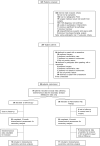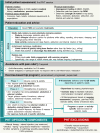Squatting biomechanics following physiotherapist-led care or hip arthroscopy for femoroacetabular impingement syndrome: a secondary analysis from a randomised controlled trial
- PMID: 38938616
- PMCID: PMC11210460
- DOI: 10.7717/peerj.17567
Squatting biomechanics following physiotherapist-led care or hip arthroscopy for femoroacetabular impingement syndrome: a secondary analysis from a randomised controlled trial
Abstract
Background: Femoroacetabular impingement syndrome (FAIS) can cause hip pain and chondrolabral damage that may be managed non-operatively or surgically. Squatting motions require large degrees of hip flexion and underpin many daily and sporting tasks but may cause hip impingement and provoke pain. Differential effects of physiotherapist-led care and arthroscopy on biomechanics during squatting have not been examined previously. This study explored differences in 12-month changes in kinematics and moments during squatting between patients with FAIS treated with a physiotherapist-led intervention (Personalised Hip Therapy, PHT) and arthroscopy.
Methods: A subsample (n = 36) of participants with FAIS enrolled in a multi-centre, pragmatic, two-arm superiority randomised controlled trial underwent three-dimensional motion analysis during squatting at baseline and 12-months following random allocation to PHT (n = 17) or arthroscopy (n = 19). Changes in time-series and peak trunk, pelvis, and hip biomechanics, and squat velocity and maximum depth were explored between treatment groups.
Results: No significant differences in 12-month changes were detected between PHT and arthroscopy groups. Compared to baseline, the arthroscopy group squatted slower at follow-up (descent: mean difference -0.04 m∙s-1 (95%CI [-0.09 to 0.01]); ascent: -0.05 m∙s-1 [-0.11 to 0.01]%). No differences in squat depth were detected between or within groups. After adjusting for speed, trunk flexion was greater in both treatment groups at follow-up compared to baseline (descent: PHT 7.50° [-14.02 to -0.98]%; ascent: PHT 7.29° [-14.69 to 0.12]%, arthroscopy 16.32° [-32.95 to 0.30]%). Compared to baseline, both treatment groups exhibited reduced anterior pelvic tilt (descent: PHT 8.30° [0.21-16.39]%, arthroscopy -10.95° [-5.54 to 16.34]%; ascent: PHT -7.98° [-0.38 to 16.35]%, arthroscopy -10.82° [3.82-17.81]%), hip flexion (descent: PHT -11.86° [1.67-22.05]%, arthroscopy -16.78° [8.55-22.01]%; ascent: PHT -12.86° [1.30-24.42]%, arthroscopy -16.53° [6.72-26.35]%), and knee flexion (descent: PHT -6.62° [0.56- 12.67]%; ascent: PHT -8.24° [2.38-14.10]%, arthroscopy -8.00° [-0.02 to 16.03]%). Compared to baseline, the PHT group exhibited more plantarflexion during squat ascent at follow-up (-3.58° [-0.12 to 7.29]%). Compared to baseline, both groups exhibited lower external hip flexion moments at follow-up (descent: PHT -0.55 N∙m/BW∙HT[%] [0.05-1.05]%, arthroscopy -0.84 N∙m/BW∙HT[%] [0.06-1.61]%; ascent: PHT -0.464 N∙m/BW∙HT[%] [-0.002 to 0.93]%, arthroscopy -0.90 N∙m/BW∙HT[%] [0.13-1.67]%).
Conclusion: Exploratory data suggest at 12-months follow-up, neither PHT or hip arthroscopy are superior at eliciting changes in trunk, pelvis, or lower-limb biomechanics. Both treatments may induce changes in kinematics and moments, however the implications of these changes are unknown.
Trial registration details: Australia New Zealand Clinical Trials Registry reference: ACTRN12615001177549. Trial registered 2/11/2015.
Keywords: Hip joint; Kinematics; Kinetics; Physical therapy; Squat.
© 2024 Grant et al.
Conflict of interest statement
David Lloyd has received research support from Arthrex and Orthopediatrics on an Australian Research Council Industrial Training and Transformation Centre grant, and from Orthocell on MTPConnect BioMedTech Horizons grant and Australian Research Council Industry Linkage grant. David J. Hunter has received consulting fees for scientific advisory roles from Pfizer, Lilly, Merck Serono, TLCBio, Kolon Tissuegene and Novartis. Nadine Foster is funded through an Australian National Health and Medical Research Council (NHMRC) Investigator Grant (ID: 2018182). No other potential Conflicts of Interest have been declared by any other authors.
Figures





References
-
- Adler RJ, Taylor JE. Random fields and geometry. New York: Springer; 2007.
Publication types
MeSH terms
LinkOut - more resources
Full Text Sources

